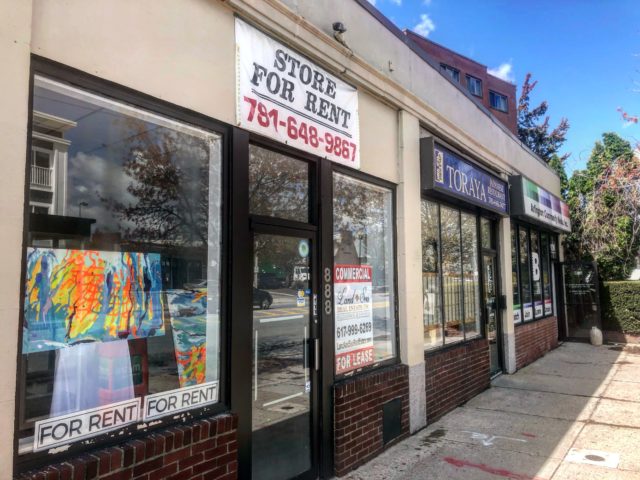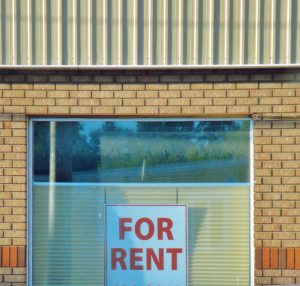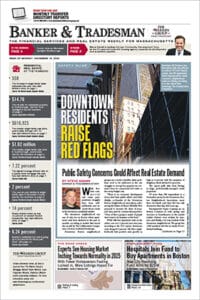Retail has been the weak link in Greater Boston’s commercial real estate boom, and one that’s attracting increased scrutiny because of vacant storefronts’ tendency to sap vibrancy and spread blight.
Boston is the latest community to consider a vacant property registry and penalties for landlords who let unused storefronts linger. District 6 City Council Matt O’Malley is calling for the implementation of an unspecified fee to be imposed upon owners of vacant storefronts, following the lead of communities such as Arlington, Lowell and New Bedford.
The debate comes amid a deluge of retail bankruptcies and store closings nationwide. U.S. retailers announced nearly 6,000 store closings through mid-April, already surpassing the total for all of 2018, according to a report by Coresight Research. Many chains still opening new stores, such as Target, have switched to smaller-footprint prototypes to save on real estate costs and overhead.

The former Barnes & Noble store at Downtown Crossing in Boston sat vacant for more than a decade before its $63 million sale in 2017 to a Chicago investor that’s renovating the 75,000-square-foot building. Image courtesy of LaSalle Investment Management
Vacancy Gives Some Landlords Tax Incentive
Several other factors play into lingering vacancies, industry experts and developers say. Two of the leading retail categories in growth mode – food vendors and fitness clubs – require odor abatement and soundproofing to coexist with upper-floor office tenants and housing. Disengaged landlords who are unwilling to maintain properties, and those content to reduce property taxes by keeping storefronts vacant, need financial incentives to put the spaces to use.
“By your very act of not leasing the space, you then can abate your taxes. To me, it’s a very perverse incentive to let the space remain vacant,” said Brian Iammartino, managing partner of Boston-based commercial developer btcRE LLC and a public policy lecturer at the Harvard Kennedy School, who supports O’Malley’s proposal but said it doesn’t go far enough.
Ted Tye, managing partner at National Development, said the concept of charging fees for retail space is unlikely to be effective.
“Only in rare cases does it make sense for a landlord not to lease or sell vacant space. There are legitimate reasons that space cannot be occupied such as market conditions, regulatory and permitting constraints, use restrictions and financing limitations,” Tye said in an email. “To create an additional burden by imposing a fee just makes things worse. It impacts landlords, lenders, and ultimately raises the rents for other tenants. Again, it is good to shine a spotlight on the concern, but this is not an optimal solution.”
Landlords who value retail space as an amenity for office or multifamily buildings need to be more flexible, said Paul Ognibene, CEO of Cambridge-based developer Urban Spaces. Ognibene is negotiating with one desirable tenant for an East Cambridge property on a nontraditional lease that waives base rent and would be based only on percentage rent. Urban Spaces is willing to lease space for as short as five years.
“We’d jump on any good tenant,” Ognibene said. “If you wait and you’re vacant for a year, you’ve lost 20 percent of your rent in a five-year lease. If you’re talking about $50 a foot and you could get $40 immediately, you’re just as well off to take it now.”

The latest survey by the town of Arlington identified 30 retail vacancies, including 24 ground-floor storefronts. Photo by Steve Adams | Banker & Tradesman Staff
Cambridge, Arlington Track Storefront Activity
In Arlington, a town official said the retail vacancy registry and fines have had a positive effect on commercial districts such as Arlington Heights and Arlington Center. The town’s latest database indicates there are still 30 retail vacancies, including 24 ground-floor storefronts. The highest vacancy rate is 9.3 percent in Arlington Heights.
The town enacted a bylaw in 2016 that imposes $400 annual fees for vacant storefronts, at a time when it had 17 vacant properties in Arlington Center. The number dropped to six within two years, and Economic Coordinator Ali Carter attributes that to the incentive created by the bylaw.
“Usually they just say they can’t find anyone and I say, ‘Well, maybe you should have it listed with a broker.’ I do find the biggest benefit is I actually get to have those conversations, and it gives us some leverage,” Carter said.
Owners of vacant commercial properties have 90 days to register with the town’s database and pay a $400 annual fee. Failure to do so can trigger a fine of $100 per day. The town offered waivers to landlords who fill vacant storefronts with art exhibits or who can demonstrate a financial hardship.
In Cambridge, a study by consultants Larisa Ortiz Assoc. identified numerous sources of ground-floor vacancies, including tax write-offs, community opposition and owners of prime spaces willing to hold out for high rents.
The city’s ground floor vacancy database identified 50 properties in its most recent report, completed in February, which equates to a 4 percent vacancy rate. That compares favorably to the national average of 10 percent, Larisa Ortiz Assoc. noted.

Steve Adams
In the study’s aftermath, the city’s retail strategy includes a program that refers landlords to arts groups and creators of pop-up spaces to activate their properties. Urban Spaces’ Ognibene said that’s one option he’s considering in the short term, in a partnership with Spaceus, a pop-up space artist collaborative founded by MIT graduates.
btCRE’s Iammartino said proposals such as O’Malley’s for vacancy fees should be calibrated to the size and valuation of properties to provide sufficient financial incentives. He cited the history of the former Barnes & Noble building in Boston’s Downtown Crossing, which sat vacant for a decade following the bookseller’s departure. LaSalle Investment Management and L3 Capital paid $63 million for the 77,000-square-foot building in 2017 and are renovating it to attract new tenants.
“That to me is the poster child for somebody who wasn’t doing anything to lease it and it left a big gash in the streetscape, then sold it for a tremendous windfall,” he said. “So, the strategy worked. Is $400 going to move the needle?”







